Invented by Mao Takashima, Aditi Chandra, Ensurge Micropower ASA
The increasing demand for humidity sensors can be attributed to several factors. Firstly, the growing awareness about the importance of maintaining optimal humidity levels in various environments has led to the widespread adoption of these sensors. In industries such as HVAC, maintaining the right humidity levels is crucial for ensuring the comfort and well-being of occupants. Humidity sensors enable precise control of humidity levels, thereby enhancing energy efficiency and improving overall indoor air quality.
Furthermore, the agriculture sector has also witnessed a surge in the use of humidity sensors. These sensors help farmers monitor and control the humidity levels in greenhouses, ensuring optimal conditions for plant growth. By maintaining the right humidity levels, farmers can prevent diseases, increase crop yield, and improve overall productivity.
The automotive industry is another major consumer of humidity sensors. These sensors are used in vehicles to measure and control the humidity inside the cabin. They play a crucial role in preventing fogging on windows, enhancing visibility, and providing a comfortable driving experience.
The healthcare sector has also recognized the importance of humidity sensors in maintaining a healthy environment. These sensors are used in hospitals, laboratories, and pharmaceutical facilities to monitor and control humidity levels, ensuring the safety and efficacy of drugs, equipment, and samples.
The market for wireless devices incorporating humidity sensors has also witnessed significant growth. Wireless devices offer the advantage of remote monitoring and control, allowing users to access real-time data and make necessary adjustments from anywhere. This has led to increased adoption in industries where continuous monitoring is required, such as agriculture and HVAC.
Methods of making humidity sensors have also evolved over time. Traditional sensors were based on resistive or capacitive principles, but advancements in technology have led to the development of more accurate and reliable sensors. For instance, some sensors now utilize thin-film capacitive sensing elements, which offer improved sensitivity and response time.
In terms of usage, humidity sensors are typically integrated into electronic devices or systems. They can be standalone sensors or part of a larger system, depending on the application. For instance, in HVAC systems, humidity sensors are often integrated with temperature sensors and controllers to achieve precise climate control.
In conclusion, the market for humidity sensors, wireless devices incorporating these sensors, and the methods of making and using them has been experiencing substantial growth. The increasing awareness about the importance of maintaining optimal humidity levels in various environments, coupled with advancements in technology, has fueled the demand for these sensors. As industries continue to prioritize energy efficiency, comfort, and productivity, the market for humidity sensors is expected to witness further expansion in the coming years.
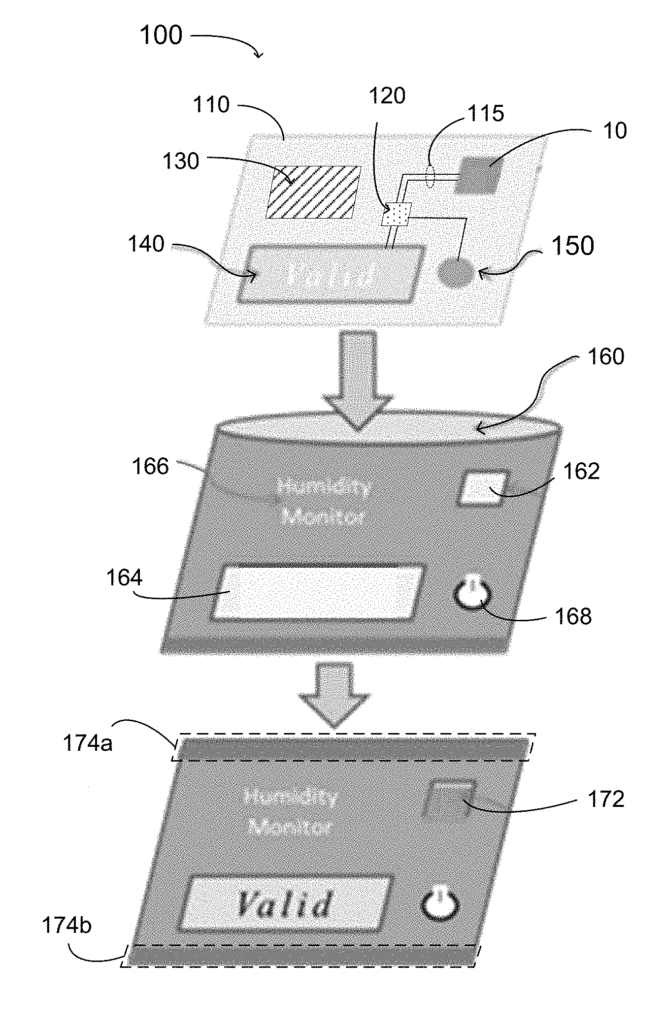
The Ensurge Micropower ASA invention works as follows
A tag or smart label with a humidity detector, as well as methods for manufacturing and using it, is disclosed. The tag or smart labels include a substrate with an antenna or battery, a moisture sensor and an integrated chip. The integrated circuit, which is electrically connected to the humidity sensor, antenna, or battery, is configured to receive a signal from a humidity sensor that corresponds to the level or value of humidity in the monitored environment, and to provide or generate a sign representing the level/value. The humidity sensor includes a first and second electrode that are predetermined distances apart, a moisture-sensitive membrane that has one or more electrical or mechanical properties that change as a function the humidity level/value and a water and/or humidification permeable membrane that covers the humidity-sensitive materials.
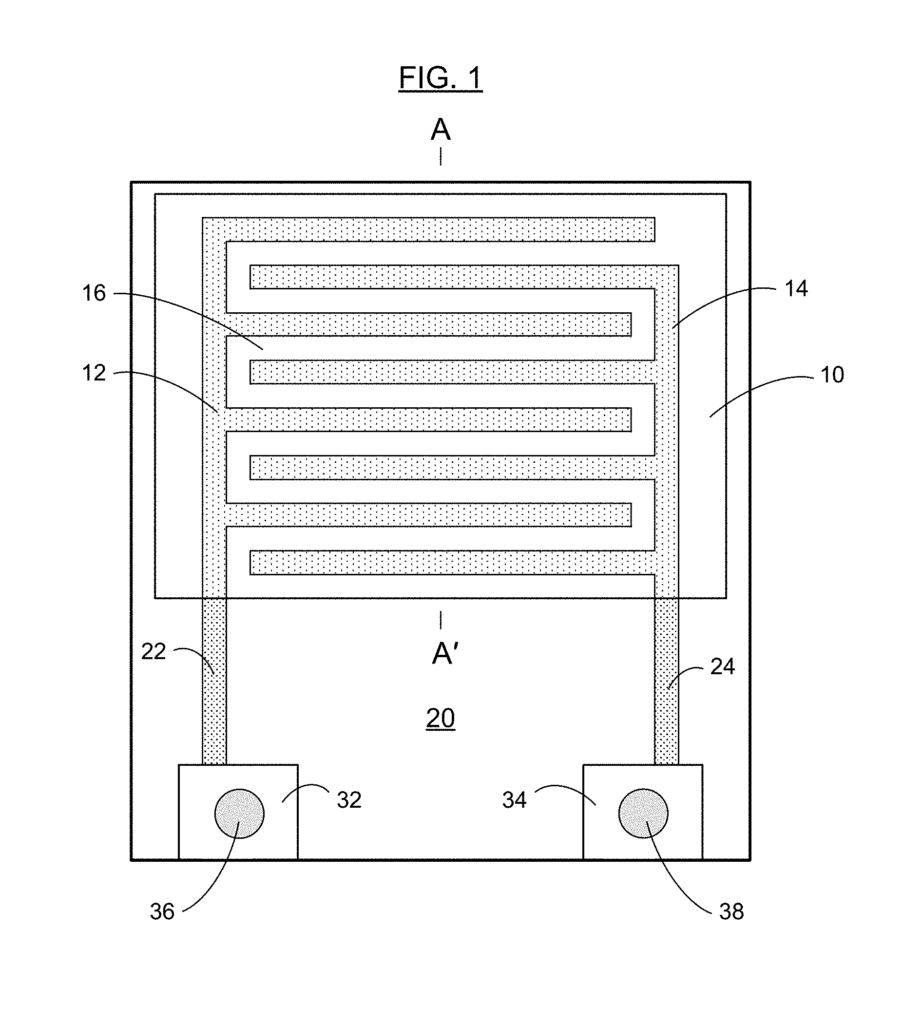
Background for Humidity Sensor, Wireless Device including the Same, and Methods of Making and Using the Same
The general humidity sensors on the market are bulky. Polymer films, such as polyvinylpyrrolidone or polyvinylalcohol (PVA), are humidity-sensitive layers. They are printable. These polymers, however, are not sensitive enough to detect humidity with a low-voltage power source found in most wireless devices. Polyelectrolytes like polystyrenesulfonic acids (PSSA), or polyethylene oxide, are also humidity-sensitive materials. However, they are not soluble with typical solvents.
The water-soluble aniline polymer copolymers were obtained by using a polymer template that is water soluble. This copolymerization may adversely impact the copolymer’s sensitivity to moisture or water.
This section is provided for background information only. This section is only for informational purposes. This ‘Discussion of Background’ contains statements that are not intended to be taken as an admission. The statements in this “Discussion Of Background” section do not constitute an admission that any of the material disclosed herein is prior art to the present disclosure. This ‘Discussion Of The Background’ section is not an admission that the subject matter disclosed in this section is prior art. No part of this ‘Discussion Of The Background? This ‘Discussion of Background’ This section may be used as an admission that any part of this application, including this?Discussion of the Background?
The present invention relates primarily to tags and devices that use radio frequency (RF or RFID), near-field communication (NFC), ultra high frequency and high frequency (UHF), and have an integrated humidity sensor.
The present invention is a tag, or smart label that includes a substrate, or backplane, with a battery, or an antenna, with a humidity-sensitive material directly or indirect on the substrate, or backplane. An integrated circuit, directly or directly on the backplane or substrate, or both, in electrical communication with the sensor, antenna, or battery. The humidity sensor can include (i) two electrodes that are spaced apart by a predetermined amount, (ii), a humidity sensitive material that has one or more chemical, electrical or mechanical properties that change in relation to the humidity value or level of an environment surrounding the tag or label, (iii), a membrane that is water and/or moisture permeable covering the humidity sensitive material. The integrated circuit can be configured to: (i) process data or information from the sensor corresponding to the level of humidity or value within the environment and (ii), provide or generate a signal representing the level or value.
In some embodiments, a smart tag or tag may also include a plurality traces connecting the various components of the backplane with the integrated circuit via different terminals. Some of the traces, for example, may connect an antenna or a battery to the integrated circuit using a first terminal set. Other traces can also electrically connect the humidifier to a terminal on a second terminal set of the integrated chip, which is different from the first terminal set.
The substrate or backplane can function as a barrier to gases and may be made of food, drug, or tobacco compatible polymer. In certain embodiments, the backplane or substrate comprises or consists a flexible metal sheet with a diffusion barrier on it and an oxide layer that is food, drug, or tobacco compatible.
In some embodiments, first and second electrodes can be interdigitated and the humidity sensor’s resistivity increases or decreases with the increase or decrease in humidity. In some embodiments, both the first and second electrodes have a plate-like shape, and the sensor’s capacitance increases or decreases with the increase or decrease in humidity. The humidity sensor can also be a transistor, with a base or gate that contains a material with a conductance and resistivity that increase or decrease as the humidity value or level in the environment increases.
The tag or smart label can also include a pouch which seals off the backplane, the integrated circuit and has a window or opening that exposes the humidity sensor. In these embodiments, the tag/smart label may also include an adhesive to seal the pouch around a first window or opening leading to the backplane or a peripheral area of or around the humidity sensor. The pouch can be made of food, drug or tobacco compatible material.
The humidity sensor can also include a second surface that supports the first and second electrodes as well as the humidity-sensitive materials. This second surface is adhered or glued to the substrate. In certain embodiments, the humidifier may also include (i) second and third base electrodes electrically coupled to the first electrodes and (ii), first and two connection terminals electrically attached to the second and third base electrodes. The first and the second connection terminals can be electrically connected with traces on the integrated circuit.
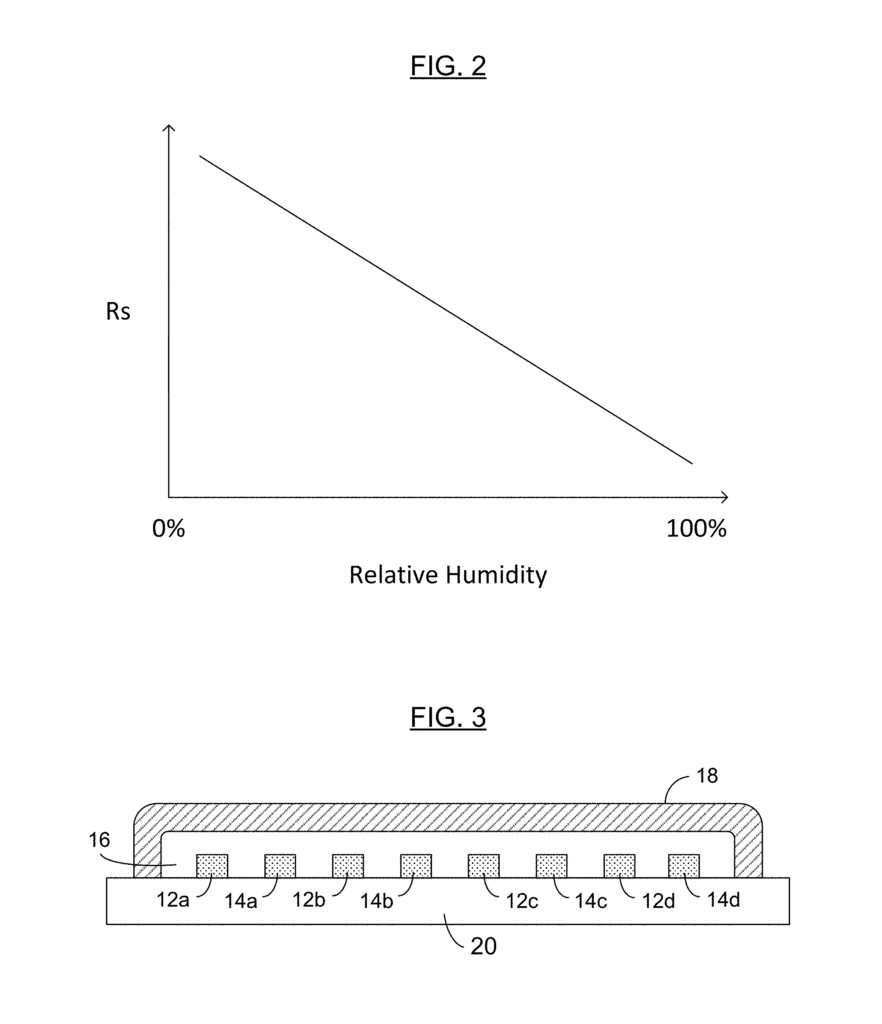
The tag or smart label can also include a second sensing element. The second sensor can be selected from a group that includes a temperature or continuity sensor, a voltage sensor, a current sensor, a voltage sensor, a power sensor, a light sensor, a time sensor, or one of more chemical sensors. In some embodiments, the sensor is connected electrically to the integrated at a third terminal set. The present tag or label can also include one or more redundant moisture sensors.
The integrated circuit can also include a memory. The memory may include one or more bits that store a value for the humidity level and a plurality bits to store an unique identification code of the container or package. The integrated circuit can also include a threshold comparator that receives an output from the humidity sensor, and/or an Analog-to-Digital Converter configured to convert the analog value or humidity level to a digital number.
In exemplary embodiments the integrated circuit includes at least one printed surface. In certain embodiments, an integrated circuit may include a number of printed layers. In one example, an integrated circuit includes at least one thin layer. In another example, an integrated circuit may include a number of thin films.
In embodiments where the tag or label includes a battery the tag/label may also include a display, and an on/off button, which are each electrically connected separately to the integrated circuit. The display, for example, is electrically coupled to the integrated at a fourth terminal set, while the on/off button is electrically attached to the integrated at one or more of the fifth terminals. The third, forth and fifth terminal sets are different than the first and second terminal sets. The tag or label that includes the antenna may also include a transmitter and/or receiver. The antenna can receive a wireless signal, which is processed by the receiver. It may then transmit or broadcast a wireless signal representing the humidity value or level of the environment where the tag or smart labels are located. The antenna can be made of a single layer of metal, with the integrated circuit acting as a strap or bridge connecting the ends.
The present tag or smart-label comprising the antenna can be part of a radio frequency and/or near field communication device. The near-field and/or radio frequency communications device can include the transmitter (e.g. a modulator), and/or receiver (e.g. a demodulator).
The present invention also relates to a package, container or packaging that surrounds the package, container or tag. The monitoring environment can be inside or outside of the package, and the sensor can be set up to measure the humidity inside or outside.
The present invention also relates to a method for manufacturing a tag, or smart label. This involves forming at least one battery or an antenna directly or indirect on a substrate, or backplane. It further comprises forming a moisture sensor directly or directly on the backplane or substrate, or forming an integral circuit directly or directly on the backplane or substrate, in electrical communication with either the humidity sensor or the battery or antenna, depending on which is present. The battery, antenna, humidity detector, and integrated chip may be the same ones described above. The method can also include forming a plurality traces on the backplane or substrate, the traces connecting the integrated to the battery and/or antenna, whichever are present.
In various embodiments, a method can also include forming a number of traces onto the substrate or the backplane. The traces connect the integrated circuit with the humidity sensor, as well as the antenna or the battery.
In certain embodiments, the humidity sensor can be formed by (i) forming both the first electrode and the second electrode on a second surface, (ii), printing the moisture-sensitive membrane over and between the two electrodes, and then (iii), forming a water- or humidity-permeable material on top of the humidity sensitive material. Alternately, forming a humidity sensor can include (i) forming a first electrode on a secondary substrate, (ii), printing the moisture-sensitive materials on or above the first electrode (iii), forming te second electrode over or on top of the humidity sensitive material (iii), and (iv), forming te water-and/or humidity permeable membrane over or on top of the humidity sensitive material. Printing can be used to form the first electrode and the second electrode. Printing can be used to form the water and/or moisture-permeable Membrane. “Forming the integrated system may include printing one of more layers (e.g. a plurality), forming the plurality of layers by one or several thin film techniques, or printing additional layers on top of one of more layers.
The method can further include forming an extra sensor, and connecting it to terminals of the integrated circuit that are different from those to which the battery and antenna or humidity sensor are connected. In certain embodiments, the method can further include forming a semiconductor in the humidity detector, with a gate or base that includes a material with a conductance and resistivity that increase or decrease as the level of humidity or value in the surrounding environment increases or diminishes.
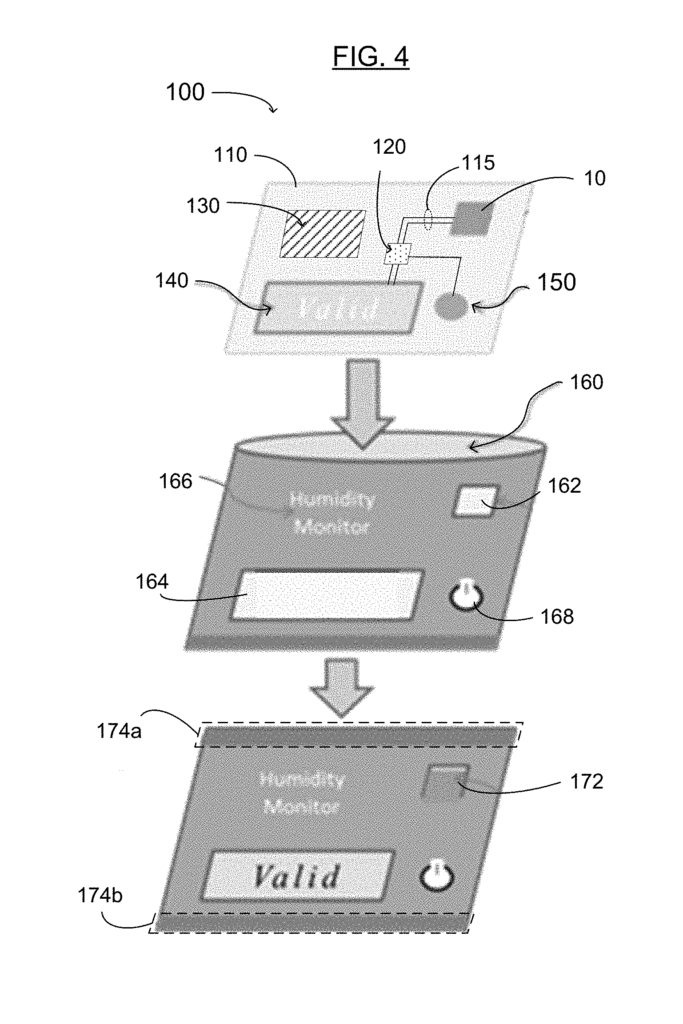
The method can further include forming a storage device that includes one or more bits to store the value of the humidity or the value, and/or multiple bits to store an unique identification code. The memory, for example, may include one or more bits that store a value related to the level of humidity or value. Printing at least one layer that contains the unique code of the container or package, (or a plurality of bits to store it) can be used to form the memory.
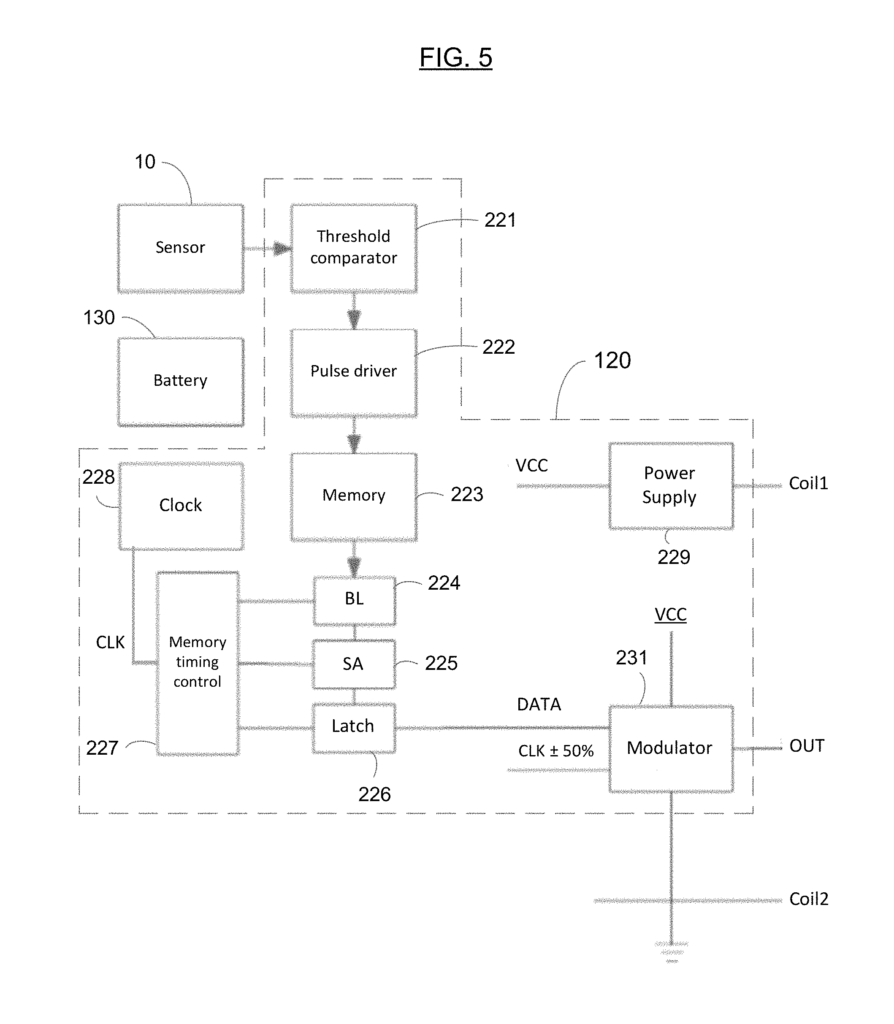
Click here to view the patent on Google Patents.
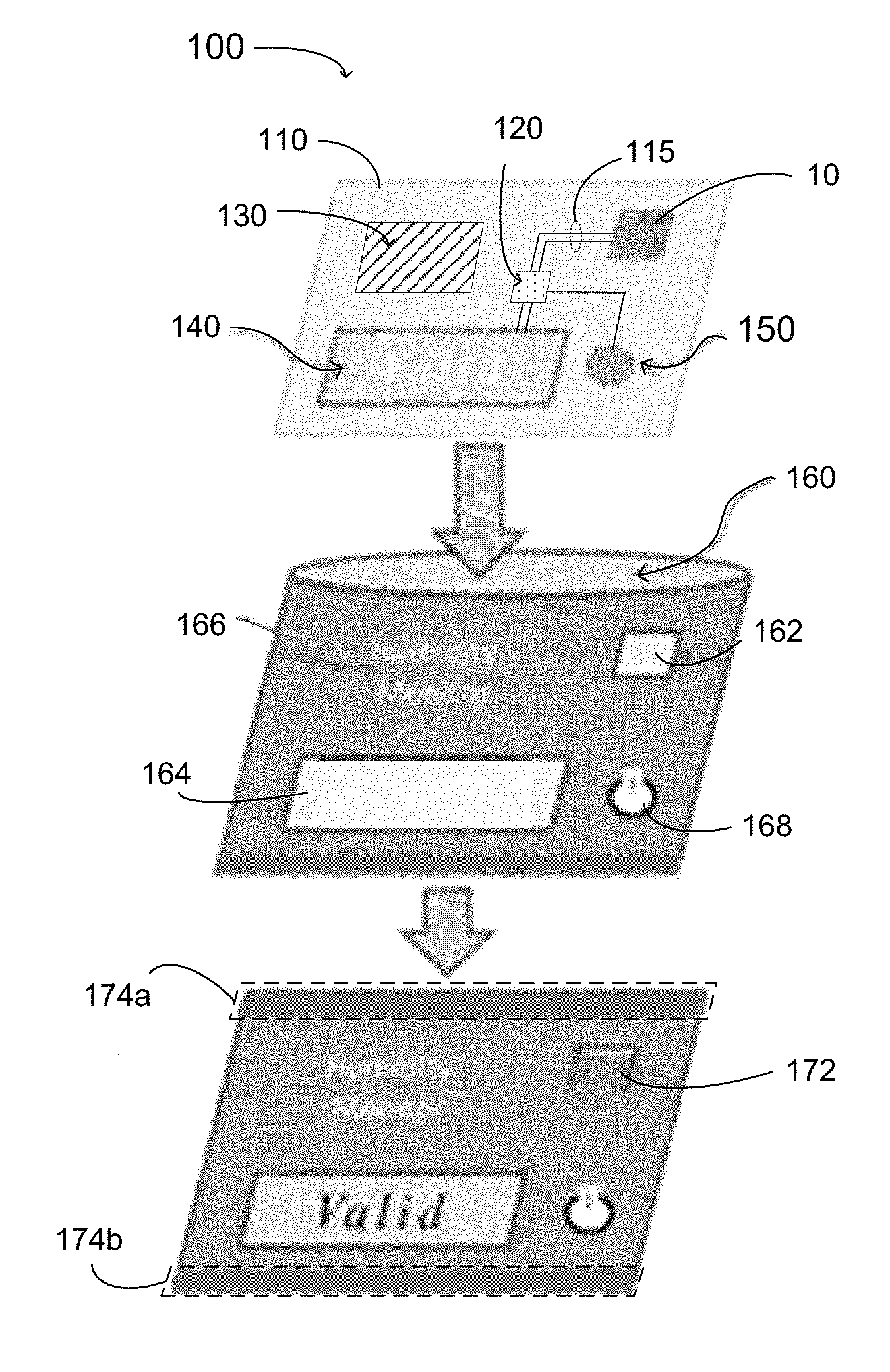
Leave a Reply